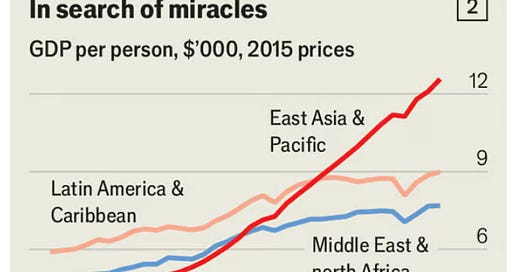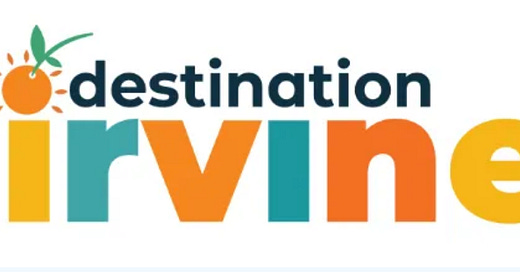

Discover more from The Pursuit of Happiness
[Note: To avoid spamming your email box with too many items, I’ve tacked on a postscript at the end of this post, which discusses a Herman Melville quote that relates to my earlier post on happiness.]
As I recall, Bastiat’s famous essay originally applied to the hidden effects of various government interventions in the economy, such as tariffs. But the concept also applies to monetary policy—especially the Fed’s impact on interest rates.
The conventional view is that monetary policy works by moving the Fed’s short-term interest rate target relative to the natural (or equilibrium) interest rate. Raising the policy rate relative to the natural rate is seen as a contractionary monetary policy.
Unfortunately, we have no direct way of measuring the natural rate of interest. By itself, this is not necessarily a fatal flaw in interest rate targeting. The natural rate can be estimated, and the policy rate can be nudged up and down relative to that estimate. It’s a workable system. So why does monetary policy occasionally go far off course?
Here is what I believe conventional economists miss, or at least under-appreciate. The major impact of Fed policy does not result from movements in the target interest rate, rather the primary impact occurs through movements in the natural interest rate. In the remainder of this post, I’ll focus on the nominal natural interest rate, which is the natural real rate plus expected inflation. It is strongly (positively) impacted by expected NGDP growth.
If the Fed adopts a highly expansionary monetary policy, as they did in 2021-22, then NGDP growth rises sharply. This dramatically raises the natural rate of interest. To prevent inflation from getting out of control, the Fed will generally raise its target rate. If it does so too slowly, it is said to be “behind the curve”, and this makes policy even more expansionary. Again, it is the gap between the policy rate and the natural rate that matters.
The top of this post shows an iceberg. The Fed’s control of their target rate is like the visible part of the iceberg. Movements in the natural interest rate are like the much bigger hidden part of the iceberg. So how does Fed policy move this hidden factor? How does it move the natural rate of interest?
If I’m right that the natural rate responds strongly to changes in NGDP growth, then almost everything the Fed does is going to impact the natural interest rate:
The Fed’s target interest rate adjustments
Everything else (especially communication about future policy)
Note that the first item moves the natural interest rate in the opposite direction. Raising the target rate may tend to make money tighter, and this will also slow expected NGDP growth, reducing the natural interest rate. In many cases, the Fed will respond with subsequent rate cuts, to match the falling natural rate.
So far, I seem to be telling a simple story. In the short run, tight money is associated with rate increases, but in the long run it leads to rate decreases. But if the story is that simple, why are rates so hard to forecast? The basic problem is the following, when the Fed moves its interest rate target; it is not immediately clear whether they are ahead of or behind the curve.
Let’s illustrate the problem by considering some scenarios for the next 12 months. It is very likely that the Fed will cut rates at the September meeting. But then what? It depends on what happens to the natural rate of interest, and that depends on whether the Fed is cutting rates at a pace that is ahead of the curve or behind the curve. Consider the following two cases:
The Fed cuts rates too sharply, triggering faster NGDP growth and a resurgence in inflation. This will lead to higher interest rates in the medium and longer run. The media will probably blame the inflation on whichever goods prices happen to rise the most rapidly.
The Fed cuts rates more slowly than the decline in the natural rate, falling behind the curve. This will lead to slower NGDP growth, depressing the natural interest rate. Eventually, the Fed will see its mistake and do some more aggressive rate cuts. If there’s a recession it won’t be blamed on the Fed, it will be blamed on the sector that seems weakest—perhaps a popped AI bubble, a weak banking sector, or a weak housing sector.
If there’s a recession, the media will probably tell you that monetary policy is “increasingly ineffective”. After all, rates will be falling and yet that won’t seem to help the economy. Pundits won’t see that the Fed cut its policy rate more slowly than the natural rate, or that the Fed’s policy is to blame for the fall in the natural rate. They’ll see the top of the iceberg, but not the huge mass underneath. Let’s hope the economy fares better than the Titanic.
Now you can see why forecasting is so difficult. The natural rate is not visible in real time. Thus when the Fed embarks on a cycle of rate cuts, we initially do not know whether it is cutting rates faster or slower than the natural rate is falling. That means we don’t know if money is getting easier or tighter. That means we don’t know if NGDP growth is likely to increase or slow. And that means we don’t know what will happen to the future path of interest rates.
You might think that the outcome would depend on whether or not the Fed decides to “go big”. Surely a 50 basis point cut makes it more likely that policy is expansionary. Alas, it doesn’t work that way. Fed policy is partly endogenous. When there is a big rate cut, it is usually because the Fed sees evidence of a sharply slowing economy, which means a rapidly falling natural interest rate. So big rate cuts are not necessarily correlated with faster future growth in NGDP. They may presage a recession.
Sorry investors, I wish I could give you a simpler story.
Postscript: Off topic, but have you ever noticed how common it is to be thinking about something, and then a day or two later find the exact same idea being discussed in a novel you are reading? This occurred to me a few days after my clumsy attempt to express the depressing thought of a colorless universe devoid of life. BTW, stories with this sort of existential dread are much scarier than tales of ghosts or vampires, which I suspect explains the popularity of Lovecraft among intellectuals.
This morning I read chapter 42 of Moby Dick, entitled The Whiteness of the Whale. In the chapter’s final paragraph, Melville evokes a colorless inhuman universe much more effectively than I ever could:
Is it that by its indefiniteness it shadows forth the heartless voids and immensities of the universe, and thus stabs us from behind with the thought of annihilation, when beholding the white depths of the milky way? Or is it, that as in essence whiteness is not so much a color as the visible absence of color; and at the same time the concrete of all colors; is it for these reasons that there is such a dumb blankness, full of meaning, in a wide landscape of snows–a colorless, all-color of atheism from which we shrink? And when we consider that other theory of the natural philosophers, that all other earthly hues–every stately or lovely emblazoning– the sweet tinges of sunset skies and woods; yea, and the gilded velvets of butterflies, and the butterfly cheeks of young girls; all these are but subtile deceits, not actually inherent in substances, but only laid on from without; so that all deified Nature absolutely paints like the harlot, whose allurements cover nothing but the charnel-house within; and when we proceed further, and consider that the mystical cosmetic which produces every one of her hues, the great principle of light, for ever remains white or colorless in itself, and if operating without medium upon matter, would touch all objects, even tulips and roses, with its own blank tinge–pondering all this, the palsied universe lies before us a leper; and like wilful travellers in Lapland, who refuse to wear colored and coloring glasses upon their eyes, so the wretched infidel gazes himself blind at the monumental white shroud that wraps all the prospect around him. And of all these things the Albino whale was the symbol. Wonder ye then at the fiery hunt?
“all deified Nature absolutely paints like the harlot” I’d cut off my right leg and replace it with a whalebone if I could write like that.
I certainly won’t claim this is the best paragraph ever written, but:
Which novel is better than Moby Dick?
Which chapter in Moby Dick is better than The Whiteness of the Whale?
Which paragraph in Chapter 42 is better than this one?
None of those are easy questions to answer.
















Serious question: of course, I'm now reading you on your new substack, but I'm using an RSS feed reader to load your articles as they're published; so, I'm not technically 'subscribed' via substack since the only way they seem to allow is for me to be sent emails letting me know each time you publish, which I don't want in my inbox (and is needles since you'll show up in my RSS reader anyway). BUT if it helps you in some way (maybe my 'subscription' to you doesn't otherwise count) then I would let substack send those emails. Please advise.
On Moby Dick, it's great, really great! But, limiting it to American authors, Huckleberry Finn is better still. One shouts, look at how utterly amazing my writing, my insights, my catalogue of everything! The other does these things and we barely notice the doings.
On best chapter, well 42 is for sure the most famous, the most Shakespeare like. But I'd argue for chapter 10, A Bosum Friend, with the great passage that ends, "Queequeg was George Washington cannibalistically developed."
The problem of using the concept of the natural rate of interest ( my respectfor Wicksell is enormous) is it argues a policy from the point of prices and not quantities. Your notion of targeting nominal income as a monetary guide solves that problem